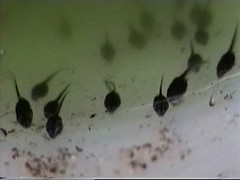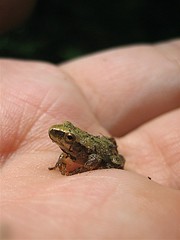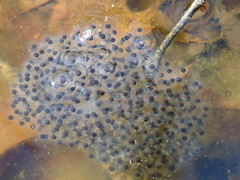In the book "Last Child in the Woods" a great deal of emphasis is placed on the authors contention that kids need places to go, on their own, to meet nature face-to-face. I heartily agree. When he died at age seventy three my father had more familiarity with nature than me, even though he had no particular interest in nature as a pursuit. But he grew up on a 15 acre homestead that was in the countryside of the early 1900's. There were few cars, primitive airplanes were almost nonexistent, and none of the neighboring farmers were upset to have my father and his wild band of brothers and friends roaming over their land. So in the course of years of just being at play he met nature in many guises and accepted them all as interesting aspects of the world he lived in. Stories of some of his encounters came down to me and my brother Terry as our father introduced us to hunting, fishing, trapping and just being observant outdoors. My brother and I never became the sporting type of outdoors men because we were growing up in a different culture. Thus many of our fathers teachings remained as lessons of the head. Perhaps the biggest one was implicit: that our opportunities to meet nature were slimmer than his had been. But neither of us ever lost touch with the enjoyment of being outdoors that our father had instilled. Even in those early 1950's when developments were putting down roots on all the best open land surrounding us we managed to have meaningful natural encounters around our small town. I believe that there are still many, though fewer, places for kids to meet nature alone, face-to-face. Safety is more of an issue in our crowded modern world, so we need to make safe venues for kids to explore on their own.
"Froggy pond" was one such place in my early life. It was a place that in some ways shaped my future from the time I was about 10. To get to Froggy Pond we walked perhaps a half mile down Pennsylvania Avenue, then slid or tottered down the ten foot railroad embankment, and finally poked along about another half mile on the seldom used track. I don’t remember the discovery of Froggy Pond. I’m sure it grew out of the sense of adventure that always came with exploring along the railroad tracks. Today that would be a big no-no if indeed anyone could find a stretch of seldom used track. Most were torn up long ago.
Froggy Pond wasn’t a pond at all. Today I would call it a seep or spring. It was a hole a foot or so deep and perhaps three feet across. Cold clear water welled up slowly from the bottom of the hole, flowed out toward the tracks, and then along a little ditch beside the tracks.Within fifteen or twenty feet the water seeped back into the ground, defining the eastern end of Froggy Pond. It wouldn’t have been an interesting place for adults, if indeed they even noticed it, but for me, my brother Terry, and my friend Bruce it was pure fascination. And that’s what kids need to really get acquainted with the natural world.
Courtesy of Clampert11 on Flickr
A Modern Reminder of Froggy Pond
There were tadpoles in Froggy Pond and tadpoles were fascinating because they were odd looking little creatures and they were fun to catch. These weren't big tadpoles like those we saw in nearby French Creek, but that didn't matter.
Courtesy of Birdybirdbits on Flickr
Tadpoles
Cupping our hands in the cold clear water we would surround a tadpole then bring our hands together to trap the soft little creature in a tiny hand-held pool. Often a tadpole would escape into the deeper water. Then we'd wait patiently for another one to wiggle into the shallows. On one ocassion we kept at it until we had perhaps twenty of the little guys. Carefully and proudly we carried them home in cans we'd found along the tracks and filled with water. We were hoping that on the way home someone would ask us what we had. Someone other than our parents that is, because we knew they would probably condemn the tadpoles back to freedom. We transferred our prized captives to gallon-size jugs of water, and stowed them in a corner of Bruce's detached garage where no adult was likely to venture. We fed them on bread crumbs sneaked from the kitchen, changed the water when it got sour, and waited. Periodically we would check in on our collection by holding the jar up and swirling the water a bit to get the tadpoles moving. And sure enough after a few weeks, or was it days, we saw tiny knobs pushing out on the sides of the tadpoles. At first they were just little bumps. Eventually they took on the unmistakable shape of legs, and soon thereafter became real legs. As the legs grew out the tail began to shorten and disappear. As these changes took place the tadpoles spent more and more of their time floating at the surface with their noses sticking out. As they changed into adult frogs this became their normal position. Without knowing it we witnessed close-up one of the multitude of truly miraculous transitions that occur in the life of every developing animal. Usually they involve the sequestered embryo, but these were right before our eyes. For certain we were learning a great lesson, but to us it was just a fun thing to do.
Flashing back to the theme of knowing in the head versus experiencing I recall that to us there were only two kinds of frogs at that time: big frogs and little frogs. But we knew far more than the names of frogs. We understood how they came to be. Later when we took our frogs down the street and asked my grandmother if we could dump them in her fish pond she was delighted to get them. She told us they were called spring peepers. So now we had some head knowledge to cap off our experience.
Courtesy of Bortolo100 on Flickr.com
Spring Peeper
Sometime later yet my grandmother showed me the gelatinous strings of eggs that a bullfrog had laid in her fishpond. She showed me where to put them in the midst of the lily pads so the goldfish would be less likely to find and eat them. I took some home in a jar of water and watched as the little dark spots in the eggs developed an elongated form and hatched into tadpoles. Then I had the complete picture of how frogs come to be.
Courtesy of "Connecticutt Birder" Linda Ruth on Flickr
Frog Eggs
Does this item remind you of an experience from your own life?
If so, please share it as a comment. Thanks!





1 comment:
How did I miss Froggy Pond? What a wonderful remembrance of a special place that helped to spark a lifetime love of nature. Your images were perfect for the story.
Post a Comment